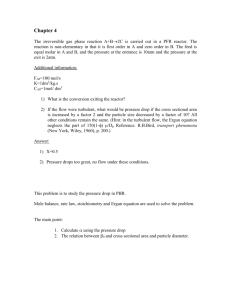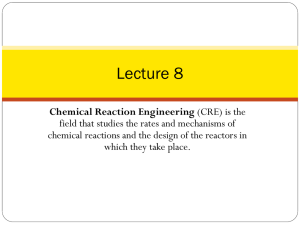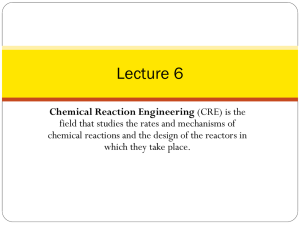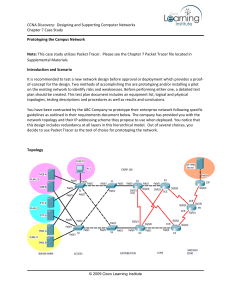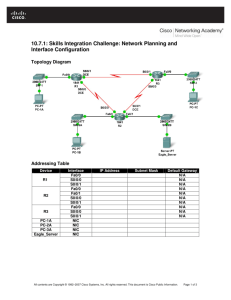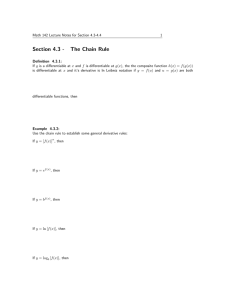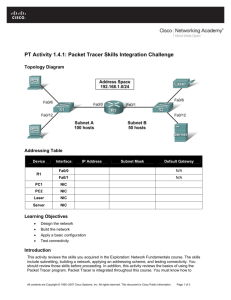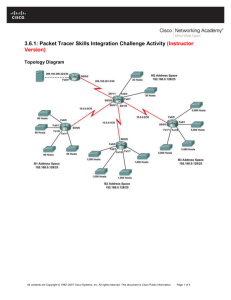New York Journal of Mathematics nondifferentiable functions James McCollum
advertisement
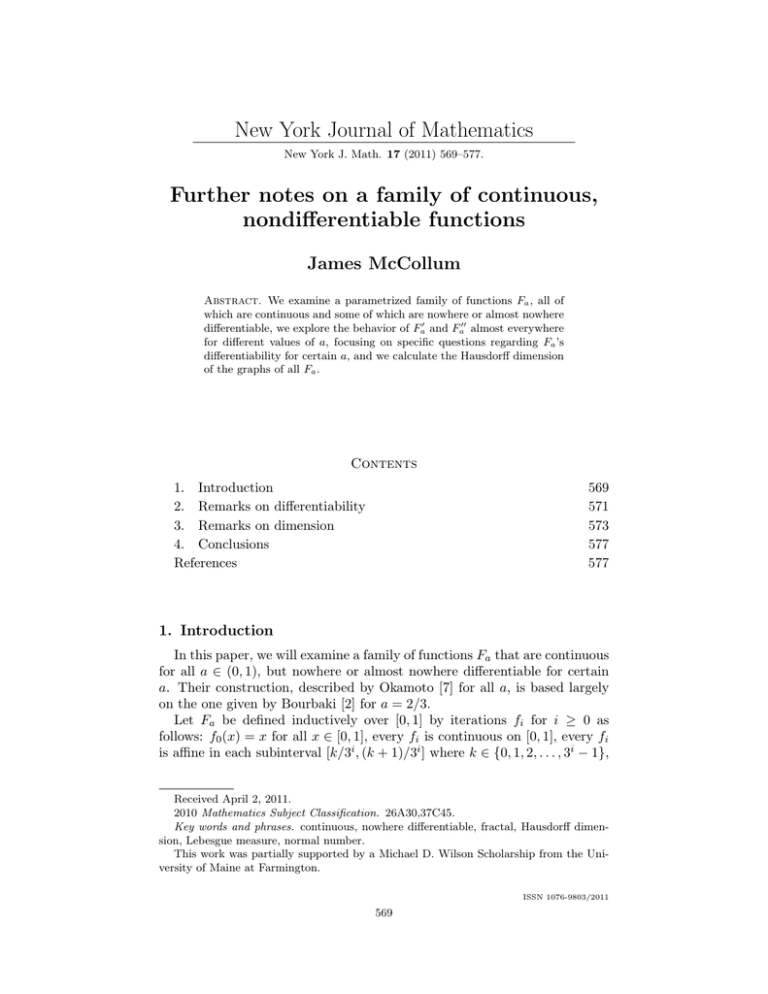
New York Journal of Mathematics
New York J. Math. 17 (2011) 569–577.
Further notes on a family of continuous,
nondifferentiable functions
James McCollum
Abstract. We examine a parametrized family of functions Fa , all of
which are continuous and some of which are nowhere or almost nowhere
differentiable, we explore the behavior of Fa0 and Fa00 almost everywhere
for different values of a, focusing on specific questions regarding Fa ’s
differentiability for certain a, and we calculate the Hausdorff dimension
of the graphs of all Fa .
Contents
1. Introduction
2. Remarks on differentiability
3. Remarks on dimension
4. Conclusions
References
569
571
573
577
577
1. Introduction
In this paper, we will examine a family of functions Fa that are continuous
for all a ∈ (0, 1), but nowhere or almost nowhere differentiable for certain
a. Their construction, described by Okamoto [7] for all a, is based largely
on the one given by Bourbaki [2] for a = 2/3.
Let Fa be defined inductively over [0, 1] by iterations fi for i ≥ 0 as
follows: f0 (x) = x for all x ∈ [0, 1], every fi is continuous on [0, 1], every fi
is affine in each subinterval [k/3i , (k + 1)/3i ] where k ∈ {0, 1, 2, . . . , 3i − 1},
Received April 2, 2011.
2010 Mathematics Subject Classification. 26A30,37C45.
Key words and phrases. continuous, nowhere differentiable, fractal, Hausdorff dimension, Lebesgue measure, normal number.
This work was partially supported by a Michael D. Wilson Scholarship from the University of Maine at Farmington.
ISSN 1076-9803/2011
569
570
JAMES MCCOLLUM
and
k
k
= fi
,
fi+1
i
3
3i
3k + 1
k
k+1
k
fi+1
= fi
+ a fi
− fi
,
i+1
i
i
3
3
3
3i
3k + 2
k
k+1
k
fi+1
=
f
+
(1
−
a)
f
−
f
,
i
i
i
3i+1
3i
3i
3i
k+1
k+1
fi+1
= fi
.
3i
3i
(1)
(2)
(3)
(4)
Given this construction, we say that
Fa = lim fi .
i→∞
We also can construct the graph of any Fa with contraction mappings,
using as a basis Katsuura’s construction [4] of the graph of F2/3 . Define
contraction mappings wn : X 7→ X, where n ∈ {1, 2, 3} and X = [0, 1]×[0, 1],
as follows: for all (x, y) ∈ X,
x
w1 (x, y) =
(5)
, ay
3
2−x
(6)
, (2a − 1)y + (1 − a)
w2 (x, y) =
3
2+x
(7)
w3 (x, y) =
, ay + (1 − a) .
3
In this case, the graph of Fa is the unique invariant set for the iterated
function system defined by (5), (6), and (7).
This paper builds primarily on a paper by Okamoto [7] regarding the same
family of functions. That paper showed, among other things, that if a0 is
the unique root of 27a2 − 54a3 = −1 in (1/2, 2/3), then Fa is differentiable
almost everwhere when a ∈ (0, 1/3)∪(1/3, a0 ); F1/3 (x) ≡ x for x ∈ [0, 1] and
thus is differentiable everywhere on that interval; Fa is differentiable almost
nowhere when a ∈ (a0 , 2/3); and Fa is differentiable absolutely nowhere
when a ∈ [2/3, 1). (Throughout this paper, “almost everywhere” and “almost nowhere” will refer specifically to sets of Lebesgues measure 1 and 0,
respectively.) Certain issues, however, were left unresolved in Okamoto’s
paper. One such issue was whether Fa0 is differentiable almost everywhere,
almost nowhere, or neither. Kobayashi [5] recently proved that Fa0 is in fact
differentiable almost nowhere using the law of the iterated logarithm.
In this paper, we will give another proof of Kobayshi’s result using only
the properties of Fa and the measure of the set of normal numbers in [0, 1].
Furthermore, using the same methods, we will describe how Fa0 behaves
almost everywhere in [0, 1] as a varies. From here, we will prove that Fa00
does not exist anywhere for any a ∈ (0, 1) except a = 1/3 (in which case
Fa (x) ≡ x, and consequently, Fa00 (x) = 0 for all x) and a = 1/2 (in which
CONTINUOUS, NONDIFFERENTIABLE FUNCTIONS
571
case Fa0 (x) = 0 for infinitely many disjoint subintervals of [0, 1]). Finally,
we will show that if a ∈ (0, 1/2], then its graph has Hausdorff dimension 1,
whereas if a ∈ (1/2, 1), then the Hausdorff dimension of its graph is equal
to log3 (12a − 3).
Acknowledgments. The author would like to thank Professor Daniel Jackson for direction and assistance with this project.
2. Remarks on differentiability
Theorem 1. If Sa is the set of all points x for which Fa0 (x) does not exist
and a0 is the unique solution of 27a2 − 54a3 = −1 in (1/2, 2/3), then the
Lebesgue measure |Sa0 | = 1.
Proof. Let Sa and a0 be defined as they are above. Now, we can write the
ternary expansion of any x ∈ [0, 1] as
∞
X
ξi
x = 0.ξ1 ξ2 . . . =
3i
i=1
where each ξi ∈ {0, 1, 2}. (If an expansion terminates, we say that it ends
with a infinite string of zeroes. If x = 1, we say that ξi = 2 for all i.) For
the first n digits of the ternary expansion of x, we define i(n) as the number
i(n)
.
of times ξi = 1 in these first n digits. Finally, we let γ = lim inf
n→∞
n
According to Okamoto [7],
Fa0 (x) = lim (3 − 6a)i(n) (3a)n−i(n)
n→∞
= lim [3(1 − 2a)γ a1−γ ]n
Fa0 (x)
n→∞
|3(1 − 2a)γ a1−γ |
and thus
= 0 if
< 1. Setting γ = 1/3, we can rewrite
the second expression as −1 < 3(1 − 2a)1/3 a2/3 < 1. Raising each side to
the third power, we get Fa0 (x) = 0 if −1 < 27a2 − 54a3 < 1; this quantity is
equal to 1 when a = 1/3, and it is equal to −1 when a = a0 .
As a result, when a = a0 and γ = 1/3, the sequence {fi0 (x)}∞
i=0 visits 1
1
and −1 infinitely often, and therefore does not converge. Thus, Fa0 0 (x) does
not exist for all x satisfying γ = 1/3. To complete the proof, we must show
that this set of values for x has Lebesgue measure 1.
To do this, we turn to the normal numbers—a set of irrational real numbers whose digits are uniformly distributed, regardless of the base in which
the numbers are written. Given any base b ≥ 2 and an alphabet of digits
{0, 1, . . . , b − 1}, a normal number x must satisfy
i(n)
1
=
n→∞ n
b
lim
1It should be noted, however, that F 0 (x) does not converge absolutely to 1, as we
a0
might expect; {fi0 (x)}∞
i=0 does not consist solely of ‘1’s and ‘−1’s, and as Kobayashi [5]
has pointed out, it contains subsequences that diverge absolutely to infinity.
572
JAMES MCCOLLUM
where n represents the same value it did for γ and i(n) can be taken as the
number of any individual digit in the first n digits of x. (While this is not
a sufficient property of normal numbers, it is a necessary one, and for the
purposes of this proof, we only need to know that all normal numbers have
this property.)
This means that the set of all x ∈ [0, 1] that satisfy γ = 1/3 includes all
the normal numbers in [0, 1]. Borel [1] proved that the set of all nonnormal
numbers has Lebesgue measure 0, so the set of all normal numbers in [0, 1]
must have Lebesgue measure 1. Because the normal numbers in [0, 1] are a
subset of the numbers satisfying γ = 1/3 in [0, 1], the latter set must have
Lebesgue measure 1. So Sa0 , the set of all x ∈ [0, 1] for which Fa0 0 (x) does
not exist, must have Lebesgue measure |Sa0 | = 1, as well.
The fact that the normal numbers have Lebesgue measure 1 in [0, 1] reveals even more about Fa0 for all a ∈ (0, 1). Because all normal numbers
satisfy γ = 1/3 in base 3, we know that the value of Fa0 (x) will depend on
whether |27a2 − 54a3 | is less than, greater than, or equal to 1 for all x in a
set with Lebesgue measure 1. This information allows us to give a general
description of the behavior of Fa0 almost everywhere:
Corollary. Let a ∈ (0, 1).
• If a ∈ [a0 , 1), then Fa0 (x) diverges for almost all x ∈ [0, 1].
• If a ∈ (0, 1/3) ∪ (1/3, a0 ), then Fa0 (x) = 0 for almost all x ∈ [0, 1].
• If a = 1/3, then Fa0 (x) = 1 for all x ∈ [0, 1].
We obtain the last result because F1/3 (x) ≡ x and thus has the same
derivative everywhere it is defined. Additionally, if we take into account the
fact that Fa (x) is absolutely nowhere differentiable in [0, 1] when a ∈ [2/3, 1),
we can replace almost all with all above when a ∈ [2/3, 1).
This leads us to our last question on the differentiability of Fa : What
can we say about the second derivative Fa00 (x) for different values of a? We
00 (x) = 0 for all x. We also know that since
know that since F1/3 (x) ≡ x, F1/3
0 (x) = 0 for all x except when x belongs to the Cantor Set—a set with
F1/2
0 (x) is continuous on a set of points with measure 1. Thus,
measure 0—F1/2
0 (x) is differentiable on this set of points, and its derivative F 00 (x) = 0
F1/2
1/2
at all of them. But clearly Fa00 (x) does not exist at any x when a ∈ [a0 , 1),
since even Fa0 (x) fails to converge for almost all x in this case. The following
theorem answers our question for the remaining values of a.
Theorem 2. For all a ∈ (0, 1/3) ∪ (1/3, 1/2) ∪ (1/2, a0 ) and all x ∈ [0, 1],
Fa00 (x) does not exist.
Proof. Let x ∈ [0, 1]. We recall from Theorem 1 that almost all x satisfy
γ = 1/3, in that the set of all such values has Lebesgue measure 1. We also
recall that for all x belonging to this set of numbers and for all a ∈ (0, 1/3) ∪
(1/3, a0 ), Fa0 (x) = 0 if |27a2 − 54a3 | < 1. So for all a ∈ (0, 1/3) ∪ (1/3, a0 )
and almost all x ∈ [0, 1], Fa0 (x) = 0.
CONTINUOUS, NONDIFFERENTIABLE FUNCTIONS
573
The graph of y = Fa0 (x) appears to be the line y = 0 over [0, 1], but
there are infinitely many points at which Fa0 (x) is undefined. Okamoto
[7] has shown that for a ∈ (0, 1/3), this set consists of all points of the
form x = (2k + 1)/(2 · 3i ), for i ≥ 0 and k ∈ {0, 1, . . . , 3i − 1} and for
a ∈ (1/3, 1/2) ∪ (1/2, a0 ), it consists of all points of the form x = k/3i . In
either case, the set of points where Fa0 (x) does not exist is dense in [0, 1].
So Fa0 (x) is discontinuous everywhere in [0, 1], and therefore its derivative,
Fa00 (x), does not exist anywhere in that interval.
So unless a = 1/3 or a = 1/2—in which case Fa00 (x) = 0 for all x at which
it exists—the graph of Fa is neither concave up nor concave down anywhere.
Also, Fa belongs to differentiability class C 0 for all a 6= 1/3.
Due to its somewhat pathological nature in terms of differentiability,
this family of functions may call to mind another set of counterintuitive
functions—that of the everywhere differentiable but nowhere monotone functions. It is clear that these two sets have no common element; indeed, the
only everywhere differentiable function in our set, F1/3 , is strictly increasing. Nevertheless, some similarities exist in the ways these sets of functions
behave on countable, dense sets. For instance, if a ∈ (0, 1/3), then on the
set of all points of the form x = k/3i , where i ≥ 0 and k ∈ {0, 1, . . . , 3i },
Fa0 (x) = 0, and at all points of the form x = (2k + 1)/(2 · 3i ), Fa0 (x) is
undefined; similarly, an everywhere differentiable but nowhere monotone
function G can be constructed over [0, 1] using the same two disjoint dense
sets under the conditions that for all x in one set, G0 (x) < 0 and that for all
x in the other set, G0 (x) > 0. Beyond this, however, the author has found
no connections between the constructions for these sets of functions. This is
primarily because with the dubious exceptions of F1/3 and F1/2 , Okamoto’s
construction assures that if Fa0 (x) = 0 on one set dense in [0, 1], then Fa0 (x)
must be undefined on another dense set.
3. Remarks on dimension
We first will show that because the graph of Fa has finite arc length when
a ∈ (0, 1/2], it has Hausdorff dimension 1.
Theorem 3. If Γa is the graph of Fa , then its Hausdorff dimension
dimH (Γa ) = 1
for all a ∈ (0, 1/2].
Proof. Suppose Γa is the graph of Fa , and suppose a ∈ (0, 1/2]. Okamoto
[7] has proven that for all a ≤ 1/2, Fa is nondecreasing. Now, if Fa is
nondecreasing, then clearly the affine pieces of each of its iteration fi must
be nondecreasing as well, since fi (k/3i ) = Fa (k/3i ) for all i ≥ 0 and all
k ∈ {0, 1, . . . , 3i }.
Using the Triangle Inequality, we can determine the maximum arc length
of Γa . We do this by applying the inequality to each affine segment of fi
574
JAMES MCCOLLUM
with respect to the segment’s horizontal and vertical components and letting
i → ∞. More precisely, if lk is the length of the affine segment of fi over
[k/3i , (k + 1)/3i ], then lk ≤ |fi ([k + 1]/3i ) − fi (k/3i )| + |(k + 1)/3i − k/3i |.
Because this inequality holds for every affine segment of fi , we can obtain
a bound for the arc length
Li =
i −1
3X
lk
k=0
of fi . And by taking the limit as i → ∞, we can express the maximum arc
length L of Γa as
i −1 i −1 3X
3X
k + 1
k
k
k
+
1
+
fi
− fi
− i .
L ≤ lim
i
i
i
i→∞
3
3
3
3
k=0
k=0
1)/3i
k/3i
1/3i
Obviously, (k +
−
=
always, so the second sum becomes
1. As for the first sum, we recall that the affine pieces of every fi are
nondecreasing, so |fi ([k + 1]/3i ) − fi (k/3i )| = fi ([k + 1]/3i ) − fi (k/3i ). Thus,
for all i,
i −1 3X
k+1
k
fi
− fi
i
3
3i
k=0
i
i
0
2
1
3
3 −1
1
− fi
+ fi
− fi
+ · · · + fi
− fi
= fi
3i
3i
3i
3i
3i
3i
= fi (1) − fi (0)
= 1.
So for a ∈ (0, 1/2], the maximum arc length of Γa is 2. To find a lower
bound for the arc length, we first note that every Γa has its endpoints at
(0,0) and (1,1). Because the shortest possible distance between these
√ two
points is a straight line, the minimum arc length of any Γa must be 2.
Hence, the graph’s 1-dimensional Hausdorff measure H1 (Γa ) satisfies 0 <
H1 (Γa ) < ∞, which implies that dimH (Γa ) = 1 for all a ∈ (0, 1/2].
For a ∈ (1/2, 1), on the other hand, Fa (x) is not nondecreasing, so we
cannot find an upper bound for L using the Triangle Inequality. In fact, no
such upper bound exists when a ∈ (1/2, 1); to prove this, we must show that
the graph’s Hausdorff dimension is greater than 1, but in order to do this,
we first must calculate the box-counting dimension of the graph.
Theorem 4. If Γa is the graph of Fa , then its box-counting dimension
dimB (Γa ) = log3 (12a − 3)
for all a ∈ (1/2, 1).
Proof. Suppose Γa is the graph of Fa , and suppose a ∈ (1/2, 1).
CONTINUOUS, NONDIFFERENTIABLE FUNCTIONS
575
To determine the box-counting dimension of Γa , we will use a variant of
the more familiar method of box-counting. Instead of counting squares of
side length δ, we will determine the smallest area A(fi ) needed to cover the
graph of iteration fi using rectangles that share a horizontal side length of
δ. Then the “number” of squares with side length δ needed to cover the
graph of fi can be expressed as Nδ (fi ) = A(fi )/δ 2 . This variant works by
the same principle as box-counting dimension with squares does, but it gives
more precise answers for each δ we use.
Letting δ = 1/3i , we see that for all Γa , A(f0 ) = 1. Using the horizontal
and vertical ratios of contraction for (5), (6), and (7), we see that
1
1
1
A(fi+1 ) = aA(fi ) + (2a − 1)A(fi ) + aA(fi )
3
3 3
4a − 1
= A(fi )
.
3
So by induction,
A(fi ) =
4a − 1
3
i
and thus,
Nδ (fi ) =
([4a − 1]/3)i
(1/3)2i
= (12a − 3)i .
So for a ∈ (1/2, 1), the box-counting dimension of Γa is
log([12a − 3]i )
i→∞ − log(1/3i )
= log3 (12a − 3).
dimB (Γa ) = lim
Next, we will show that the Hausdorff dimension of Γa is equal to its
box-counting dimension by the Mass Distribution Principle (see, e.g., [3]):
Theorem 5. If Γa is the graph of Fa , then its Hausdorff dimension
dimH (Γa ) = log3 (12a − 3)
for all a ∈ (1/2, 1).
Proof. We consider a small variation on Katsuura’s construction of Γa using
contraction mappings. Let E0 = [0, 1] × [0, 1] and define further levels of the
construction by Ei+1 = w1 (Ei ) ∪ w2 (Ei ) ∪ w3 (Ei ) where i > 0 and w1 , w2 ,
and w3 are mappings (5)–(7). Clearly Ei+1 ⊂ Ei for all i ≥ 0, and
∞
\
Ei = Γa .
i=0
This last relationship between the Ei s can be understood as follows: While
in Okamoto’s construction, linear segments are constructed “upwards” to
576
JAMES MCCOLLUM
a graph with infinite length, in this construction, rectangular regions are
constructed “downwards” to the same graph which has zero area. Moreover,
we see that each Ei can be covered by 3i rectangles of length (1/3)i .
Using methods related to the box-counting process in Theorem 4, it can
be shown that if a ∈ (1/2, 1), then the area of Ei+1 can be expressed as
1
1
1
A(Ei+1 ) = a
A(Ei ) + (2a − 1)
A(Ei ) + a
A(Ei )
3
3
3
4a − 1
=
A(Ei ),
3
4a − 1 i
for all i ≥ 0.
and since A(E0 ) = 1, we have A(Ei ) =
3
Now, let µ be the natural mass distribution on Γa ; we start with unit
mass on E0 and repeatedly “spread” this mass over the total area of each
Ei . Also, let U be any set whose diameter |U | < 1. Then there exists some
i ≥ 0 such that
i+1
i
1
1
≤ |U | <
,
3
3
an inequality that applies to any U satisfying 0 < |U | < 1. Given these
conditions on the diameter of U , it is clear that for every U , there is some
i such that U is contained in an open square of side length (1/3)i and U
contains points in at most two level-i “sub-rectangles.”
Hence, the area of U is bounded above by the area of the open square
containing it; that is, A(U ) ≤ (1/9)i . In terms of measure, we know that
the entire area of U can be contained in Ei , so
A(U ∩ Ei )
µ(U ) ≤
A(Ei )
(1/9)i
≤
([4a − 1]/3)i
i
1
≤
.
12a − 3
i+1
i
1
1
And since
≤ |U | implies that
≤ 3|U |, we have
3
3
i log3 (12a−3)
1
1
µ(U ) ≤
=
≤ (3|U |)log3 (12a−3)
12a − 3
3i
= (12a − 3)|U |log3 (12a−3) ,
and therefore, by the Mass Distribution Principle,
log3 (12a − 3) ≤ dimH (Γa ) ≤ dimB (Γa ),
and given the upper bound obtained in Theorem 4, we have
dimH (Γa ) = log3 (12a − 3).
CONTINUOUS, NONDIFFERENTIABLE FUNCTIONS
577
This means that if a > 1/2, then dimH (Γa ) > 1. And if the Hausdorff
dimension of Γa exceeds 1, then its one-dimensional Hausdorff measure—
that is, its length—must be infinite. So for a > 1/2, the graph’s arc length
L indeed has no upper bound.
Given the result of Theorem 5, it is clear that dimH (Γa ) ranges continuously between 1 and 2 for all a ∈ (1/2, 1). This means that for a ∈ (1/2, 1),
Γa meets the criterion of a fractal, being a self-similar set whose Hausdorff
dimension exceeds its topological dimension.
4. Conclusions
In his paper, Okamoto [7] posed another question related to Fa ’s differentiability: If a ∈ (0, 1/3), there are infinitely many x for which Fa0 (x) is
finite but nonzero, but how do we classify them? In the corollary to Theorem 1, we have provided a partial answer to this question. Since Fa0 (x) = 0
if a ∈ (0, 1/3) and x satisfies γ = 1/3, we know that the points in question
at least must be nonnormal numbers in [0, 1]. It follows that the set of such
points must occupy a subset of [0, 1] with Lebesgue measure 0.
References
[1] Borel, Émile. Les probabilités dénombrables et leurs applications arithmétiques.
Rendiconti del Circolo Matematico di Palermo 27 (1909), no. 1, 247–71.
[2] Bourbaki, Nicolas. Functions of a real variable. Elementary theory. Trans. from the
1976 French original [MR 0580296] by Philip Spain. Springer-Verlag, Berlin, 2004.
xiv+338 pp. ISBN: 3-540-65340-6. MR2013000, Zbl 1085.26001.
[3] Falconer, Kenneth. Fractal geometry. Mathematical foundations and applications.
Second edition. John Wiley & Sons, Inc., Hoboken, NJ, 2003. xxviii+337 pp. ISBN:
0-470-84861-8. MR2118797 (2006b:28001), Zbl 1060.28005.
[4] Katsuura, Hidefumi. Continuous nowhere-differentiable functions—an application
of contraction mappings. American Mathematical Monthly 98 (1991), no.5, 411–416.
MR1104304 (92c:26005), Zbl 0752.26005.
[5] Kobayashi, Kenta. On the critical case of Okamoto’s continuous non-differentiable
functions. Proc. Japan Acad. Ser. A Math. Sci. 85 (2009), no. 8, 101–104. MR2561897
(2010m:26006), Zbl 1184.26003.
[6] McCollum, James. Properties of Bourbaki’s function. Preprint arXiv:1009.2817.
[7] Okamoto, Hisashi. A remark on continuous, nowhere differentiable functions. Proc.
Japan Acad. Ser. A Math. Sci. 81 (2005), no. 3, 47–50. MR2128931 (2006a:26005),
Zbl 1083.26004.
Division of Mathematics and Computer Science, University of Maine at Farmington, Farmington, ME 04938
james.mccollum@maine.edu
This paper is available via http://nyjm.albany.edu/j/2011/17-24.html.
